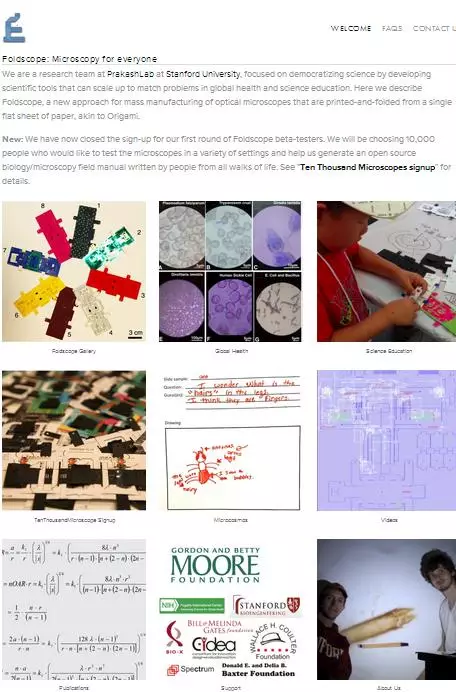Print magic with five websites: The Noel D'cunha Sunday Column
The Internet is a platform for designers to share and discuss contemporary issues in print practice as well as the turning points and the ever-changing nature of graphic design.
20 Jun 2014 | By Noel D'Cunha
According to the Stanford team, "Foldscope is an origami-based, print-and-fold optical microscope that can be assembled from a flat sheet of paper. Although it costs less than a dollar in parts, it can provide over 2,000X magnification with sub-micron resolution (800nm), weighs less than two nickels (8.8 g), is small enough to fit in a pocket (70 × 20 × 2 mm3), requires no external power, and can survive being dropped from a three-storey building or stepped on by a person.
Its minimalistic, scalable design is inherently application-specific instead of general-purpose gearing towards applications in global health, field-based citizen science and K12-science education.
http://www.foldifyapp.com/
As the mantra on the print site says, create, print, fold.
Foldify featured on App Store “10 Apps That WOW”! This is what the report said, “Simple yet completely engrossing, this iPad-tailored app gives you the means to create actual foldable paper toys. Start by designing highly customisable characters, cars, and buildings on screen, then print and fold them into real, physical paper creations.”
It's as simple as that. So much so Bell Printer's Vashikaran Rajendrasingh's five-year-old son uses it do design nifty folding carton samples for the Sivakasi-based firm.
The Foldify team worked on the app in 2011. According to Wired magazine, "The key feature of Foldify is that it marries the second and third dimensions — as you edit the design on the right, you can see how it’ll come out in a panel on the left. This happens to be the first feature they designed."
Once they had a technical prototype, the team worked on the UI. This meant brainstorming, paper prototyping and photoshopping.
Foldify's first prototype showed that it was feasible to draw in 2D and render to 3D on the iPad in real time. And that's how it was. Foldify simplified design. Ask Vashikaran's five year old child.
http://www.printeresting.com
As a website, which reviews portals, described printinteresting.com, "this one is a thinking person’s favourite online resource for interesting printmaking".
From “fine art” prints and limited edition multiples to photocopied flyers and cheap inkjet printouts, the website takes a view of printmaking; all manner of printed matter has a place at Printeresting.
Authored by multiple contributors, the site features regular posts on a range of print-related content, including artwork, news, reviews, technology, and critical discourse. While our primary goal is to highlight innovative print work, the site is also a place to keep abreast of developments in the field, and to take note when printmaking intrudes into popular culture.
This is what Simon Lewis of HP Israel, in an interaction recently told me. “Versioned or event-driven personalisation, perhaps can be called mass customisation and that is where the opportunity is; that is where ‘Share a Coke’ campaign become meaningful.”
http://www.printwiki.org
An interesting website for print gyaan, this project was started in late 2006 by Adam Dewitz of whattheythink.com (another great resource for the print community). In 2007, the project announced a number of improvements to the website and an addition of the Encylopedia of Graphic Communication by the print guru, Frank Romano. The website is hosted by Whattheythink.
The aim of the project is to foster an environment in which everyone can contribute and edit the content. It’s an open-source knowledge base of information on the printing and graphic communication industry. Everyone can contribute and edit content.
Unlike Wikipedia, no anonymity is permitted. You can source information, but if you have to edit, you will have to first create an account, because PrintWiki says it exists with the desire to build connection between those that use, make or consume print.
The website at present has 7,866 pages and has been indexed in a way, which keeps all the pages well organised. It's time to have someting as comprehensive for the Indian print industry. Be it: offset, gravure, flexo, corrugation, screen-print, digital.
Yes, basically everything.
During Interpack one of the really nice things was the three-dimensional (3D). A quick chat with technologists indicated how 3D is becoming commonplace. Our sister magazine Stuff is showcasing one of these in their latest issue. This is a profile of Div By Zero Technologies in Kharghar (Navi Mumbai), which is expanding the range of “printable” materials. Soon everything and anything will be 3D printed. From metals, to body tissue, to ingredients in a samosa and even your dreams.
This is where LUXeXcel, a company based in the Netherlands comes into play. The Dutch technology uses it to print some reading glasses. As it has been reported, LUXeXcel, in March opened a factory near its headquarters in Goes to print lenses for light-emitting diodes (LEDs). The media report says, "With low-energy consumption and a service life extending to many years, LEDs are steadily replacing traditional bulbs and tubes in most domestic, urban and industrial lighting."
LUXeXceL is an inventor of Printoptical Technology, a revolutionary and disruptive 3D printing process, capable to print smooth optical structures and lenses as prototypes or in manufacturing volumes.
The “one-step-CAD-to-Optic” process enables the manufacturing of smooth printed optical components directly from our printers, the process does not require post processing, which is a fundamental innovation in 3D printing!

















 See All
See All